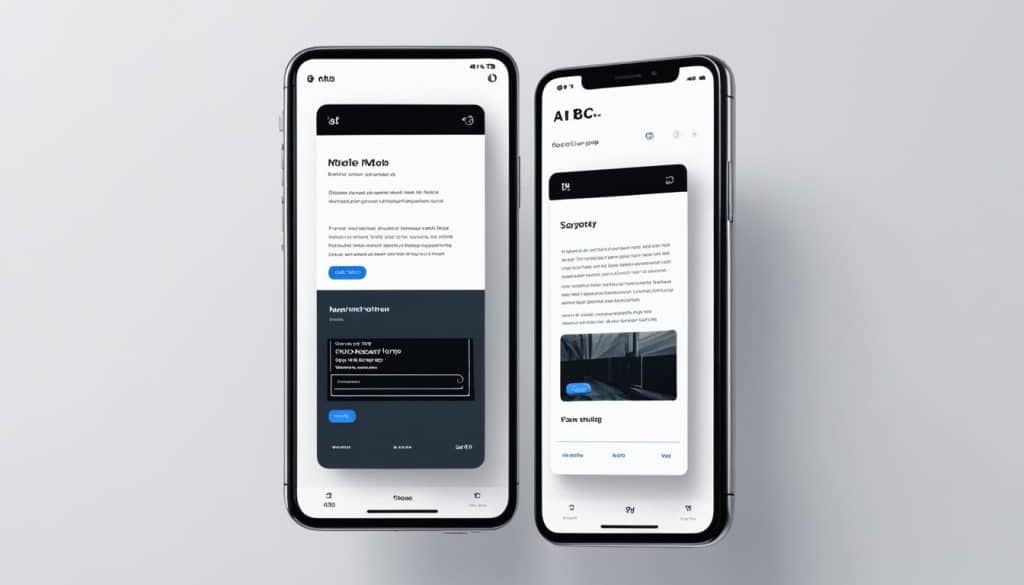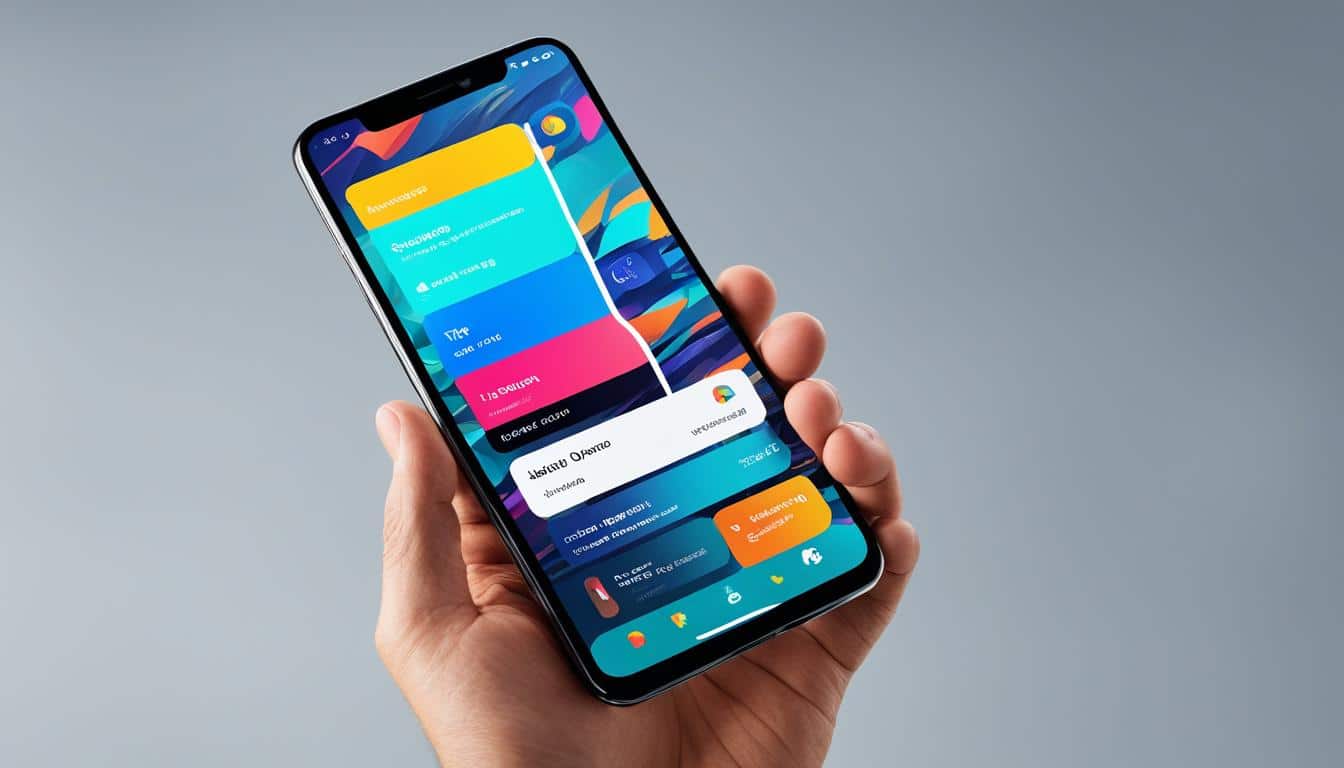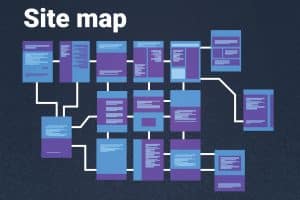Mobile optimization is key today to ensure a smooth user experience on mobile devices. With more people using mobiles, making your site mobile-friendly is a must. It boosts website performance, improves mobile user experience, and speeds up mobile website speed. This also helps your site rank better in mobile searches.
By using mobile-friendly design and responsive web design, you can make your site better for mobile SEO. This approach helps you stand out in the competitive online world.
- Mobile optimization is essential for a seamless user experience on mobile devices.
- Implement responsive web design and mobile-friendly principles for better mobile SEO.
- Enhance website performance and mobile website speed to improve user satisfaction.
- Prioritize mobile-first indexing and mobile search rankings to stay competitive.
- Optimizing for mobile is key in today’s mobile world.
The Evolution of Mobile UX
Mobile UX has changed a lot with the rise of smartphones. Devices like the iPhone and Android smartphones changed how we use them. What started as simple calls and texts now includes shopping, banking, and more.
Mobile UX is now a big part of design. It focuses on making experiences good for smartphone users. It considers the unique features of mobiles, like small screens and touch interfaces.
The growth of mobile UX is linked to smartphone tech. Touchscreens and new features like accelerometers have made interactions better. These changes have made mobiles more than just phones.
Today, smartphones are more than phones. They help us in many ways, like being personal assistants and entertainment hubs. So, mobile UX is very important for businesses.
When designing for mobile, think about screen size, load times, and easy navigation. Mobile apps and sites should be easy to use. This lets users find what they need quickly.
As mobiles keep changing, businesses need to keep up with mobile UX trends. There are many new features, like gesture-based navigation and dark mode, to explore. These can make mobile experiences even better.

| Key Elements | Description |
|---|---|
| Responsive Design | Adapting to different screen sizes and orientations for optimal usability. |
| Intuitive Navigation | Clear menus, buttons, and gestures for easy and seamless exploration. |
| Quick Loading | Fast page load times to prevent user frustration and abandonment. |
| Touch-Friendly | Designing elements that are easily interactable with touchscreens. |
| Important Content | Prioritizing essential information for quick access and visibility. |
| User Testing | Regularly testing mobile experiences with real users for feedback and iteration. |
By incorporating these key elements and staying abreast of emerging trends, businesses can deliver exceptional mobile experiences that captivate and delight users.
Key Elements of Mobile UX Design
Creating a great mobile user experience (UX) means focusing on key areas. These include making sure it’s responsive, easy to navigate, and loads quickly. It should also be touch-friendly and include only the most important content. Testing with real users is also essential.
Responsive Design
A responsive design makes sure your site or app works well on any screen size. This lets users easily access and interact with your content. It ensures a smooth experience on all devices, from smartphones to tablets.
Easy Navigation
Easy navigation is key for mobile users. Use clear menus and intuitive buttons. Make sure gestures are simple, so users can move around without getting stuck.
Quick Loading Times
Slow loading times are a big no-no for mobile users. Make sure your pages and content load fast. This will give users a smooth and efficient user experience.
Touch-Friendly Interactions
Mobile users mostly use touch to interact with their devices. So, your UX should be touch-friendly. Ensure buttons and elements are easy to tap and not too crowded. This prevents accidental actions.
Important Content
Focus on important content and present it neatly. Keep in mind the small screen size of mobile devices. Make sure key info is easy to find. Cut down on clutter to highlight what’s most important.
Testing with Users
Test your mobile experiences with real users often. This feedback is invaluable. By watching how users interact, you can spot and fix issues. User testing ensures your mobile UX meets your audience’s needs.

| Key Elements | Description |
|---|---|
| Responsive Design | Ensures seamless functionality on any screen size |
| Easy Navigation | Clear menus, intuitive buttons, and gestures for smooth navigation |
| Quick Loading Times | Optimize page and content loading for a fast user experience |
| Touch-Friendly Interactions | Buttons and elements designed for easy touch interaction |
| Important Content | Prioritize and present key information in a clear and organized manner |
| Testing with Users | Gather feedback and insights through regular user testing |
Emerging Trends in Mobile UX
Keeping up with the latest trends is key in Mobile UX. Here are some trends shaping the future:
- Gesture-based navigation: Users can now interact with devices through gestures, not just buttons. This makes for a smoother experience.
- Dark mode: Dark mode is popular for its look and battery-saving benefits. It reduces eye strain and improves the user experience.
- Augmented reality integration: Mobile apps are using AR for immersive experiences. This lets users interact with digital content in real life, making UX better.
- Voice user interfaces (VUIs): VUIs let users control devices with voice commands. This is handy for those with limited dexterity or who prefer not to use their hands.
- Personalization and AI recommendations: AI is making mobile UX more personal. Apps use user data to offer tailored content and experiences.
- Progressive web apps (PWAs): PWAs offer the best of web and app experiences. They work well on all devices, giving users a seamless experience.
- Biometric authentication: Biometric features like fingerprints and facial recognition are making devices more secure. They ensure safe access to devices and sensitive info.
- Sustainability and green UX: Mobile UX is now focusing on being green. It aims to save energy, reduce carbon footprints, and promote eco-friendly designs.
- Accessibility advances: Mobile UX is getting more inclusive. New tech is helping designers create experiences for everyone, ensuring equal access to info and functions.
- Multi-modal experiences: Users often switch between devices. Mobile apps are now designed to work well across different devices, making transitions smooth.
By keeping up with these trends, businesses can lead in the mobile UX field. They can deliver top-notch experiences to their users.
A/B/C Testing for Mobile UX Enhancement
A/B/C testing, or split testing, is great for improving mobile UX. It involves testing different designs and features to make better choices and boost conversions.
Through A/B/C testing, companies can learn what users like and improve their mobile UX. The goal is to increase the number of users who complete actions, like filling out forms or making purchases.
By testing and refining mobile UX, businesses can create a better experience for mobile users.
Benefits of A/B/C Testing:
- Improved understanding of user preferences
- Data-driven decision-making
- Increase in conversions and desired user actions
- Identification of areas for improvement
- Enhanced mobile UX performance
To do effective A/B/C testing, businesses should follow these steps:
- Define the goals: Know what you want to achieve and what KPIs to track for mobile UX.
- Identify test elements: Pick what you want to test, like button colors or different copywriting.
- Create test variants: Make several versions of your mobile UX with the chosen test elements.
- Randomize test groups: Split users into groups randomly to get fair results.
- Collect data: Use analytics to track how users interact with each version.
- Analyze results: Look at the data to find trends and areas to improve.
- Implement changes: Use the test results to make your mobile UX better.
- Monitor and iterate: Keep checking how your mobile UX is doing and make changes as needed.
A/B/C testing helps businesses make smart choices to improve mobile user experience. By testing and tweaking mobile UX, companies can keep up with what users want.
The secret to good A/B/C testing is to focus on conversion optimization and better user experience. Use data to guide your decisions.

Types of Usability Testing for Mobile UX Evaluation
Usability testing is key for checking how well mobile devices work for users. It shows how users interact with mobile products and if they work well. By watching real users, usability testing finds problems and ways to get better.
Using different testing strategies helps improve mobile UX design. This makes user experiences on mobile devices better.
User Testing
User testing watches real users use a mobile website or app. It gives insights into how well the design works. It finds problems and shows how to make it better.
Remote Testing
Remote testing lets businesses test with people from anywhere. It’s good because it gets feedback from many places. It’s easy to do through video or special platforms.
Eye Tracking Studies
Eye tracking studies track where users look on a mobile website or app. It shows what catches their eye. This helps make the interface better for users.
Cognitive Walkthroughs
Cognitive walkthroughs look at how users think when using a mobile device. It checks if instructions are clear and if the interface is easy to use. It helps find and fix problems.
These testing strategies help find and fix problems. They make mobile UX better and improve user experiences.
| Usability Testing Strategies | Description |
|---|---|
| User Testing | Observing real users as they complete tasks on a mobile website or app to gather insights on usability issues and areas for improvement. |
| Remote Testing | Conducting usability testing with participants located in different locations through video conferencing or user testing platforms. |
| Eye Tracking Studies | Using specialized equipment to monitor users’ eye movements and assessing where they focus their attention on the mobile interface. |
| Cognitive Walkthroughs | Evaluating the mobile UX from a user’s perspective to assess clarity, information presentation, and overall intuitiveness. |

Prototype Testing for Mobile UX Enhancement
Prototype testing is key in making mobile experiences better. It lets businesses test their designs before they launch. This way, they can fix problems and make their mobile UX better.
There are many types of prototypes, like wireframes and interactive mockups. By testing these, businesses can make sure their designs are easy to use and look good on mobile devices.
Types of Prototypes for Mobile UX Testing
There are different prototypes for testing mobile UX. Each one helps designers get feedback and check if their designs work well. Here are a few:
- Low-fidelity wireframes: These are simple sketches that show the layout of a mobile app or website. They help spot big design problems early on.
- Interactive mockups: These are more detailed and show how the final product will work. They let designers test more and get detailed feedback.
- High-fidelity prototypes: These look almost like the real thing. They have detailed designs and work like the final product. They’re great for advanced testing.
Using different prototypes helps businesses test and improve their mobile UX designs. This ensures the final product meets user needs and expectations.
The Benefits of Prototype Testing
Prototype testing has many benefits for mobile UX design:
- Early identification of issues: Testing prototypes helps find and fix problems early. This makes the final product better.
- Feedback-driven design decisions: Testing prototypes gives valuable feedback. This helps businesses make design choices based on what users like.
- Enhanced user experience: Testing prototypes makes mobile UX better. It makes the product more user-friendly and visually appealing.
Prototype testing is vital for creating great mobile experiences. It helps businesses make better design choices and deliver a product that users love.
Lean UX Methodology for User Experience Strategy
Lean UX focuses on making things better for users through quick testing and improvement. It’s based on lean development and emphasizes teamwork, feedback, and always getting better. Lean UX puts the user first and uses data to improve the experience. By using lean UX, businesses can make their UX strategy better, streamline design, and create mobile experiences that users love.
Key Principles of Lean UX
- Collaboration: Work together as a team to solve design problems.
- Minimalism: Focus on the most important features that add value.
- Rapid prototyping: Make quick prototypes to get feedback and improve designs.
- Data-driven decision making: Use feedback and data to make design choices and improve the user experience.
Benefits of Lean UX
Lean UX brings many advantages to businesses looking to improve their user experience:
- Efficiency: Lean UX’s iterative approach speeds up design cycles. This lets businesses quickly adapt to user needs and market changes.
- User-focused design: By keeping users involved, businesses get insights. They can then create experiences that truly meet user expectations.
- Data-backed decisions: Lean UX uses data and feedback to guide design choices. This ensures improvements are based on solid evidence and user preferences.
- Reduced risks: Quick prototyping and testing catch problems early. This reduces the chance of expensive redesigns or failed launches.
Implementing lean UX methodology empowers businesses to continuously enhance their design, align with user expectations, and deliver compelling mobile experiences.
“Lean UX is about bringing the true nature of a product to light faster, in a collaborative, cross-functional way.” – Jeff Gothelf
| Key Concepts | Description |
|---|---|
| Continuous iteration | Constantly refining and improving the user experience through small, incremental changes. |
| Minimum Viable Product (MVP) | Developing and launching a basic version of a product with essential features to gather feedback and validate assumptions. |
| Usability testing | Evaluating the usability of a design by observing real users and incorporating their feedback into the iterative process. |
Defining UX Requirements through User Stories and Use Cases
User stories and use cases are key in making mobile experiences better. User stories tell us how users interact and what they want. Use cases show how users use a product, helping designers spot what’s needed and what might go wrong.
Using user stories and use cases helps businesses understand what users need. This makes designs more focused on the user. It also helps designers tackle specific design challenges. Together, they make mobile experiences that meet user needs well.
“User stories and use cases provide a deep understanding of user requirements, enabling designers to align their designs with user expectations and desires.”
Starting with user stories and use cases early in design gives businesses key insights. These insights shape the UX strategy. This approach makes sure the final product meets user expectations, leading to a better mobile experience.
Benefits of User Stories and Use Cases:
- Help designers understand user needs and behaviors
- Provide insights to align design with user expectations
- Identify specific requirements and possible issues
- Influence the entire UX strategy
- Enable prioritizing features and functionalities
- Create a user-centric and tailored mobile experience
“User stories and use cases empower businesses to create impactful and user-centric mobile experiences by aligning design decisions with user needs and expectations.”
Shaping the Mobile User Experience through Information Architecture
Information architecture is key to a good mobile user experience. It organizes information well, making mobile sites and apps easy to use. Using good information architecture, like clear menus and information design, improves usability and website navigation.
Good information architecture makes mobile UX design better. It helps users navigate easily and find what they need. This makes the mobile experience better for everyone.
Also, good information architecture makes mobile experiences look good. It presents content clearly, making it easy for users to understand and engage. By focusing on information design, businesses can make mobile sites and apps that are both good-looking and easy to use.
Information architecture is vital for mobile UX design. It improves usability, makes website navigation better, and presents information well. By using good information architecture, businesses can create mobile experiences that are great for users.
FAQ
What is mobile optimization?
Mobile optimization makes websites work better on phones and tablets. It improves the user experience on mobile devices.
Why is mobile optimization important?
More people use phones and tablets to go online. Optimizing your website for mobile improves mobile SEO and the user experience. It also makes your site faster and can help it rank better in mobile searches.
What is responsive web design?
Responsive web design makes sure a website looks good on any screen size. It’s key for making websites work well on phones and tablets. This way, everyone can easily use the site, no matter their device.
How does mobile optimization affect SEO?
Mobile optimization is very important for SEO. It helps a website rank better in mobile searches. If a site isn’t mobile-friendly, it might not do well in search results.
What is mobile-first indexing?
Mobile-first indexing means search engines look at the mobile version of a website first. This makes having a mobile-friendly site very important. It helps attract more mobile users and improve visibility.
How can I enhance the mobile user experience?
To make mobile browsing better, focus on a few things. Use responsive design and make navigation easy. Make sure the site loads fast and works well with touch. Also, put the most important content first and test the site with real users.
What are some emerging trends in mobile UX?
New trends in mobile UX include gesture-based navigation and dark mode. There’s also augmented reality integration and voice user interfaces. Other trends are personalization and AI recommendations, progressive web apps, and biometric authentication. There’s also a focus on sustainability and green UX practices, accessibility advances, and designing for multi-modal experiences.
What is A/B/C testing for mobile UX enhancement?
A/B/C testing, or split testing, is a way to improve mobile user experience. It involves testing different designs and features to find what works best. This helps increase conversions and improve the site.
What types of usability testing can be used for mobile UX evaluation?
Usability testing is key for checking how well a mobile site works. You can use user testing, remote testing, eye tracking studies, and cognitive walkthroughs. These methods help find and fix problems.
Why is prototype testing important for mobile UX enhancement?
Prototype testing is important for getting feedback and making improvements. It helps ensure a mobile site is easy to use and looks good. This is before the site or app is launched.
What is lean UX methodology?
Lean UX focuses on creating value for users through quick testing and improvement. It’s about working together, getting feedback, and always trying to do better. This approach makes mobile experiences better for users.
How can user stories and use cases help define UX requirements?
User stories and use cases are great for understanding what users need. User stories tell stories of how users interact with a product. Use cases show how users use a product or system. These tools help designers create better experiences.
How does information architecture shape the mobile user experience?
Information architecture is vital for a good mobile user experience. It organizes information to make it easy to use and navigate. By following best practices, businesses can make mobile sites that are easy to use and fun to explore.





